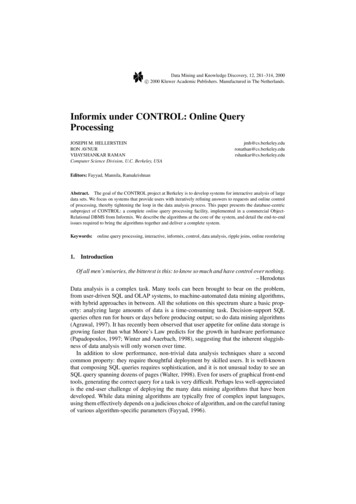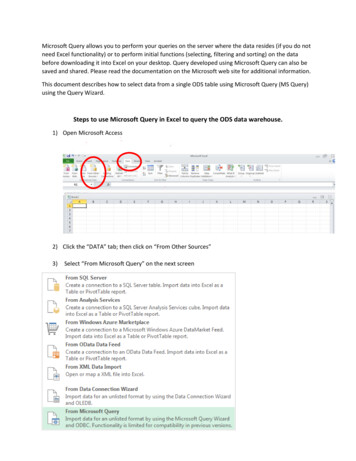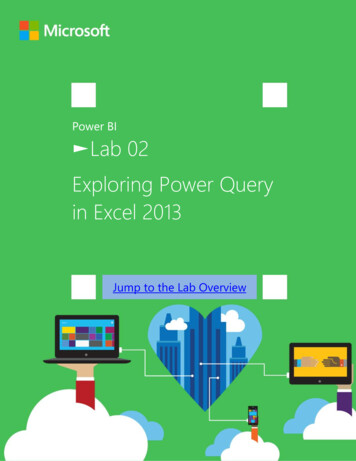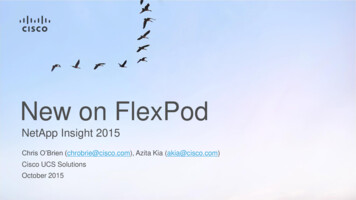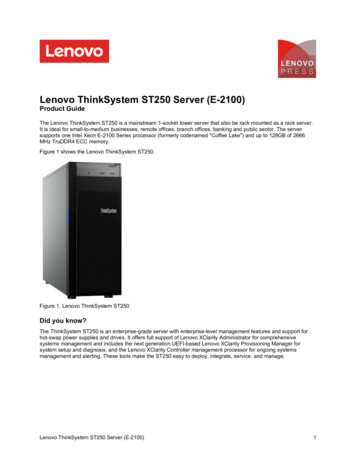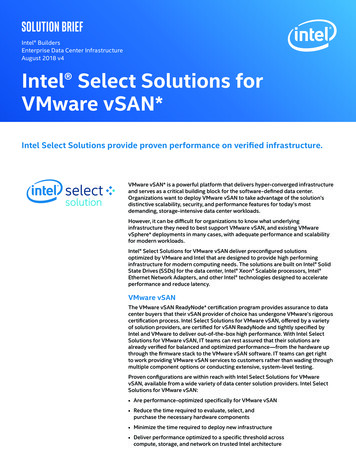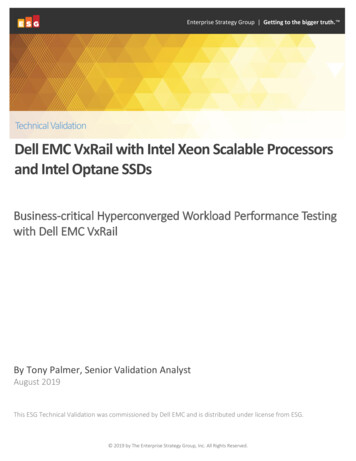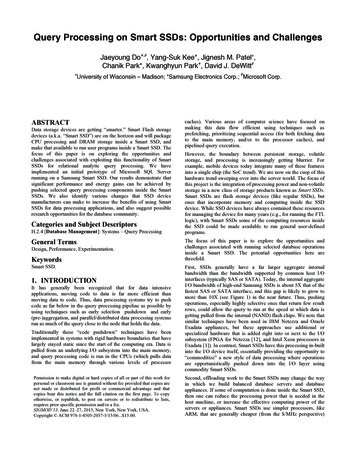
Transcription
Query Processing on Smart SSDs: Opportunities and ChallengesJaeyoung Do ,#, Yang-Suk Kee*, Jignesh M. Patel ,Chanik Park*, Kwanghyun Park , David J. DeWitt# #University of Wisconsin – Madison; *Samsung Electronics Corp.; Microsoft Corp.ABSTRACTData storage devices are getting “smarter.” Smart Flash storagedevices (a.k.a. “Smart SSD”) are on the horizon and will packageCPU processing and DRAM storage inside a Smart SSD, andmake that available to run user programs inside a Smart SSD. Thefocus of this paper is on exploring the opportunities andchallenges associated with exploiting this functionality of SmartSSDs for relational analytic query processing. We haveimplemented an initial prototype of Microsoft SQL Serverrunning on a Samsung Smart SSD. Our results demonstrate thatsignificant performance and energy gains can be achieved bypushing selected query processing components inside the SmartSSDs. We also identify various changes that SSD devicemanufacturers can make to increase the benefits of using SmartSSDs for data processing applications, and also suggest possibleresearch opportunities for the database community.Categories and Subject DescriptorsH.2.4 [Database Management]: Systems – Query ProcessingGeneral TermsDesign, Performance, Experimentation.KeywordsSmart SSD.1. INTRODUCTIONIt has generally been recognized that for data intensiveapplications, moving code to data is far more efficient thanmoving data to code. Thus, data processing systems try to pushcode as far below in the query processing pipeline as possible byusing techniques such as early selection pushdown and early(pre-)aggregation, and parallel/distributed data processing systemsrun as much of the query close to the node that holds the data.Traditionally these “code pushdown” techniques have beenimplemented in systems with rigid hardware boundaries that havelargely stayed static since the start of the computing era. Data ispulled from an underlying I/O subsystem into the main memory,and query processing code is run in the CPUs (which pulls datafrom the main memory through various levels of processorPermission to make digital or hard copies of all or part of this work forpersonal or classroom use is granted without fee provided that copies arenot made or distributed for profit or commercial advantage and thatcopies bear this notice and the full citation on the first page. To copyotherwise, or republish, to post on servers or to redistribute to lists,requires prior specific permission and/or a fee.SIGMOD’13, June 22–27, 2013, New York, New York, USA.Copyright ACM 978-1-4503-2037-5/13/06. 15.00.caches). Various areas of computer science have focused onmaking this data flow efficient using techniques such asprefetching, prioritizing sequential access (for both fetching datato the main memory, and/or to the processor caches), andpipelined query execution.However, the boundary between persistent storage, volatilestorage, and processing is increasingly getting blurrier. Forexample, mobile devices today integrate many of these featuresinto a single chip (the SoC trend). We are now on the cusp of thishardware trend sweeping over into the server world. The focus ofthis project is the integration of processing power and non-volatilestorage in a new class of storage products known as Smart SSDs.Smart SSDs are flash storage devices (like regular SSDs), butones that incorporate memory and computing inside the SSDdevice. While SSD devices have always contained these resourcesfor managing the device for many years (e.g., for running the FTLlogic), with Smart SSDs some of the computing resources insidethe SSD could be made available to run general user-definedprograms.The focus of this paper is to explore the opportunities andchallenges associated with running selected database operationsinside a Smart SSD. The potential opportunities here arethreefold.First, SSDs generally have a far larger aggregate internalbandwidth than the bandwidth supported by common host I/Ointerfaces (typically SAS or SATA). Today, the internal aggregateI/O bandwidth of high-end Samsung SSDs is about 5X that of thefastest SAS or SATA interface, and this gap is likely to grow tomore than 10X (see Figure 1) in the near future. Thus, pushingoperations, especially highly selective ones that return few resultrows, could allow the query to run at the speed at which data isgetting pulled from the internal (NAND) flash chips. We note thatsimilar techniques have been used in IBM Netezza and OracleExadata appliances, but these approaches use additional orspecialized hardware that is added right into or next to the I/Osubsystem (FPGA for Netezza [12], and Intel Xeon processors inExadata [1]). In contrast, Smart SSDs have this processing in-builtinto the I/O device itself, essentially providing the opportunity to“commoditize” a new style of data processing where operationsare opportunistically pushed down into the I/O layer usingcommodity Smart SSDs.Second, offloading work to the Smart SSDs may change the wayin which we build balanced database servers and databaseappliances. If some of computation is done inside the Smart SSD,then one can reduce the processing power that is needed in thehost machine, or increase the effective computing power of theservers or appliances. Smart SSDs use simpler processors, likeARM, that are generally cheaper (from the /MHz perspective)
I/O InterfaceHost InterfaceControllerInternal ollerDRAMControllerFlashControllerFlash ChannelFlashFlashFlash Memory ArrayFlash ChannelFlashFlashDRAMFlash SSD2015201420132012201120102009Figure 2: Internal architecture of a modern SSD200812007Bandwidth Relative tothe I/O Interface Speed100YearFigure 1: Bandwidth trends for the host I/O interface (i.e., SAS/SATAstandards), and aggregate internal bandwidth available in high-endenterprise Samsung SSDs. Numbers here are relative to the I/Ointerface speed in 2007 (375 MB/s). Data beyond 2012 are internalprojections by Samsung.than the traditional processors that are used in servers. Thus,database servers and appliances that use Smart SSDs could bemore efficient from the overall price/performance perspective.Finally, pushing processing into the Smart SSDs can reduce theenergy consumption of the overall database server/appliance. Theenergy efficiency of query processing can be improved byreducing its running time and/or by running processing on the lowpower processors that are typically packaged inside the SmartSSDs. Lower energy consumption is not only environmentallyfriendly, but often leads to a reduction in the total cost ofoperating the database system. In addition, with the trend towardsdatabase appliances, energy starts becoming an importantdeployment consideration when the database appliances areinstalled in private clouds on premises where getting additional(many kilowatts of) power is challenging.To explore and quantify these potential advantages of using SmartSSDs for DBMSs, we have started an exploratory project toextend Microsoft SQL Server to offload database operations ontoa Samsung Smart SSD. We wrote simple selection andaggregation operators that are compiled into the firmware of theSSD. We also extended the execution framework of SQL Serverto develop a simple (but with limited functionality) workingprototype in which we could run simple selection and aggregationqueries end-to-end.Our results show that for this class of queries, we observed up to2.7X improvement in end-to-end performance compared to usingthe same SSDs but without the “Smart” functionality, and up to a3.0X reduction in energy consumption. These early results,admittedly on queries using a limited subset of SQL (e.g., nojoins), demonstrate that there are potential opportunities for usingSmart SSDs even in mature commercial and well-optimizedrelational DBMSs.Our results also point out that there are a number of challenges,and hence research opportunities, in this new area of running dataprocessing programs inside the Smart SSDs.First, the processing capabilities available inside the Smart SSDthat we used are very limited by design. It is clear from our resultsthat adding more computing power into the Smart SSD (andmaking it available for query processing) could further increaseboth performance and energy savings. However, the SSDmanufacturers will need to determine if it is economical andtechnically feasible to add more processing power – issues such asthe additional cost per device and changes in the device energyprofile must be considered. In a sense, this is a chicken-and-eggproblem since the SSD manufacturers will add more processingpower only if more software makes use of an SSD’s “smart”features while the software vendors need to become confident inthe potential benefits before investing the necessary engineeringresources. We hope that our work provides a starting point forsuch deliberations.Second, the firmware development process we followed to runuser code in the Smart SSDs is rudimentary. This can be apotential challenge for general application developers. BeforeSmart SSDs can be broadly adopted, the existing development anddebugging tools and runtime system (Section 3) need to be muchmore user-friendly. Further, the ecosystem around the Smart SSDsincluding communication protocols and the programming,runtime, and usage models need to be investigated in-depth.Finally, the query execution engine and query optimizer of theDBMS must be extended to determine when to push an operationto the SSD. Implications of running operations in the Smart SSDsalso extend out to query optimization, DBMS buffer pool cachingpolicies, transaction processing, and may require re-examininghow aspects such as database compression are used. In otherwords, the DBMS internals have to be modified to make use ofSmart SSDs in a production setting.The remainder of this paper is organized as follows: Thearchitecture of a modern SSD is presented in Section 2. In Section3 we describe how Smart SSDs work. Experimental results arepresented in Section 4. Related work is discussed in Section 5.Finally, Section 6 contains our concluding remarks and points tosome directions for future work.2. BACKGROUND: SSD ARCHITECTUREFigure 2 illustrates the general internal architecture of a modernSSD. There are three major components: SSD controller, flashmemory array, and DRAM.The SSD controller has four key subcomponents: host interfacecontroller, embedded processors, DRAM controller, and flashmemory controllers. The host interface controller implements abus interface protocol such as SATA, SAS, or PCI Express (PCIe).The embedded processors are used to execute the SSD firmwarecode that runs the host interface protocol, and also runs the FlashTranslation Layer (FTL), which maps Logical Block Address(LBA) in the host OS to the Physical Block Address (PBA) in theflash memory. Time-critical data and program code are stored inthe SRAM. Today, the processor of choice is typically a lowpowered 32-bit RISC processor, like an ARM series processor,
GETOPENHostInterfaceCLOSEHost MachineCommunicationProtocolProprietary SSD FirmwareApplication Programing ser-Defined ProgramsFlash SSDFigure 3: Smart SSD runtime frameworkwhich typically has multiple cores. The controller also has onboard DRAM memory that has higher capacity (but also higheraccess latency) than the SRAM.The flash memory controller is in charge of data transfer betweenthe flash memory and DRAM. Its key functions include runningthe Error Correction Code (ECC) logic, and the Direct MemoryAccess (DMA). To obtain higher I/O performance from the flashmemory array, the flash controller uses chip-level and channellevel interleaving techniques. All the flash channels share accessto the DRAM. Hence, data transfers from the flash channels to theDRAM (via DMA) are serialized.The NAND flash memory array is the persistent storage medium.Each flash chip has multiple blocks, each of which holds multiplepages. The unit of erasure is a block, while the read and writeoperations in the firmware are done at the granularity of pages.3.2 Application Programming Interface (API)Once a command has been successfully delivered to the devicethrough the Smart SSD communication protocol (Section 3.1), theSmart SSD runtime system drives the user-defined program in anevent-driven fashion. The user program can use the Smart SSDAPIs for command management, thread management, memorymanagement, and data management. The design philosophy of theAPIs is to give more flexibility to the program, so that it is easierfor the end-user programs to use these APIs. These APIs arebriefly described below. 3. SMART SSDs FOR QUERY PROCESSINGThe Smart SSD runtime framework (shown in Figure 3)implements the core of the software ecosystem that is needed torun user-defined programs in the Smart SSDs.3.1 Communication Protocol Since the key concept of the Smart SSD (that we explore in thispaper) is to convert a regular SSD into a combined computing andstorage device, we needed a standard mechanism to enable theprocessing capabilities of the device at run-time. We havedeveloped a simple session-based protocol that is compatible withthe standard SATA/SAS interfaces (but could be extended forPCIe). The protocol consists of three commands – OPEN, GET,and CLOSE. OPEN, CLOSE: A session starts with an OPEN commandand terminates with a CLOSE command. Once the sessionstarts, runtime resources including threads and memory (seeThread and Memory APIs in Section 3.2) that are required torun a user-defined program are granted, and a unique sessionid is then returned to the host. Note that when one of theother Smart SSD commands (i.e., GET and CLOSE) isinvoked by the host, the session id must be provided to findthe corresponding session before the command is executed inthe Smart SSDs. The CLOSE command closes the sessionassociated with the session id; it terminates any runningprogram and releases all resources that are used by theprogram. Once the session is closed, the correspondingsession id is invalid, and can be recycled.GET: The host can monitor the status of the program andretrieve results that the program generates via a GETcommand. This command is mainly designed for thetraditional block devices (based on SATA/SAS interfaces), inwhich case the storage device is a passive entity andresponds only when the host initiates a request. For PCIe, amore efficient command (such as PULL) could be introducedto directly leverage device-initiated capabilities (e.g.,interrupts). A single GET command retrieves both therunning status of the program and the results if the output isready. With different session ids, multiple user-definedprograms can be executed in parallel. Note that the programscan be blocked if no resource is available in the Smart SSD.Therefore, the polling interval should be adaptive so that itdoes not introduce a large polling overhead or hinder theprogress of the Smart SSD operations. In our experiments,the polling interval was set to 10 msec. Command APIs: Whenever a Smart SSD command (i.e.,OPEN, GET, and CLOSE) is passed to the device, the SmartSSD runtime system invokes the corresponding callbackfunction(s) registered by the user-defined program. Forinstance, the OPEN and CLOSE commands trigger userdefined open and close functions respectively. In contrast,the GET command calls functions to fill the running status ofthe program and to transfer results to the host if available.Thread APIs: Once a session is opened, the Smart SSDruntime system creates a set of worker threads and a masterthread per core dedicated to the session. All threads managedby the runtime system are non-preemptive. A worker threadis scheduled when a Smart SSD command arrives (seeCommand APIs above), or when a data page (8KB) is loadedfrom flash to DRAM (see Data APIs below). Once scheduled,a user-registered callback function for that event is invokedon the thread (e.g., an open function in the event of theOPEN command). Since callback functions are designed tobe “quick” functions, long-running operations that arerequired for each page (such as filtering) are handled by aspecial function that is executed in the master thread. Wenote that the current version of the runtime system does notsupport a “yield” command that gives up the processor toother threads. To simulate this behavior when the masterthread is scheduled, the operation processes only a few pages,before the master thread is rescheduled to deal with the nexttask (which could be to process the next set of pages for thefirst task).Memory APIs: Smart SSD devices typically have two typesof memory modules – a small fast SRAM (e.g., ARM’sTightly Coupled Memory), and a large slow DRAM. In atypical scenario, the DRAM is mainly used to store datapages while the SRAM is used for frequently accessedmetadata such as the database table schema. Once a session
is open, a pre-defined amount of memory is assigned to thesession, and this memory is returned back to the Smart SSDruntime system when the session is closed (i.e., dynamicmemory allocation using malloc and free is not allowed.)Data APIs: Multiple data pages can be loaded from flash toDRAM in parallel. Here, the degree of parallelism dependson the number of flash channels employed in the Smart SSD.Once loaded, the pages are pinned to ensure that they are notevicted from the DRAM. After processing a page, it must beunpinned to release the memory required to hold the pageback to the device. Otherwise, Smart SSD operations mightbe blocked until enough memory is available for thesubsequent operations.4. EVALUATIONIn this section, we present results from an empirical evaluation ofSmart SSD with Microsoft SQL Server.4.1 Experimental Setup4.1.1 WorkloadsFor our experiments, we used the LINEITEM table defined in theTPC-H benchmark [30] and three synthetic tables (Synthetic4,Synthetic16, and Synthetic64) that consist of 4 integer columns,16 integer columns, and 64 integer columns respectively.Our modifications to the original LINEITEM table specificationsare as follows:1)2)3)We used a fixed-length char string for the variable-lengthcolumn, L COMMENT,All decimal numbers were multiplied by 100 and stored asintegers,All date values were converted to the numbers of days sincethe last epoch.These changes resulted in 148 byte-sized tuples. The LINEITEMdata was populated at a scale factor of 100 (600M tuples, 90GB).In addition, we created three synthetic tables, called Synthetic4,Synthetic16, and Synthetic64, each of which has 400M tuples.The sizes of these tables are 10GB, 30GB and 110GB for theSynthetic4, the Synthetic16, and the Synthetic64 tablesrespectively.The data in the LINEITEM table and the synthetic tables wasinserted into a SQL Server heap table (without a clustered index).By default, the tuples in these tables were stored in slotted pagesusing the traditional N-ary Storage Model (NSM). For the SmartSSDs, we also implemented the PAX layout [3] in which all thevalues of a column are grouped together within a page.4.1.2 Hardware/Software SetupAll experiments were performed on a system running 64bitWindows 7 with 32GB of DRAM (24 GB of memory is dedicatedto the DBMS). The system has two Intel Xeon E5430 2.66GHzquad core processors, each of which has a 32KB L1 cache, andtwo 6MB L2 caches shared by two cores. For the OS and thetransactional log, we used two 7.5K RPM SATA HDDs,respectively. In addition, we used a LSI four-port SATA/SAS6Gbps HBA (host bus adapter) [22] for the three storage devicesthat we used in our experiments. These three devices are:1)2)3)A 146GB 10K RPM SAS HDD,A 400GB SAS SSD, andA Smart SSD prototyped on the same SSD as above.200Time (second) SAS SSDSmart arget TableFigure 4: End-to-end elapsed time for a selection query at aselectivity of 0.1% with the three synthetic tables Synthetic4,Synthetic16, and Synthetic64.Only one of three devices is connected to the HBA at a time foreach experiment. Finally, the power drawn by the system wasmeasured using a Yokogawa WT210 unit (as suggested in [26]).We used this server hardware since it was compatible with theLSI HBA card that was needed to run the extended host interfaceprotocol described in Section 3.1.We recognize that this box has a very high base energy profile(235W in the idle state) for our setting in which we use a singledata drive; hence, we expect the energy gains to be bigger whenthe Smart SSD is used with a more balanced hardwareconfiguration. But, this configuration allowed us to get initial endto-end results.We implemented simple selection and selection with aggregationqueries in the Smart SSD by using the Smart SSD APIs (Section3.2). We also modified some components in SQL Server 2012[23] to recognize and communicate with the Smart SSD throughthe Smart SSD communication protocol (Section 3.1). For eachtest, we measured the elapsed wall-clock time, and calculated thedisk energy consumption by summing the time discretized realenergy values over the elapsed time. After each test run, wedropped the pages in the main-memory buffer pool to start with acold buffer cache on each run. Thus, all the results presented hereare for cold experiments; i.e., there is no data cached in the bufferpool prior to running each query.4.2 Experimental ResultsTo aid the analysis of the results that are presented below, the I/Ocharacteristics of the HDD, SSD, and Smart SSD are shown inTable 1. The bandwidth of the HDD and the SSD was obtainedusing Iometer [15]. For the Smart SSD internal bandwidth, weimplemented a simple program (by using the Smart SSD APIsintroduced in Section 3.2) to measure the wall clock time tosequentially fetch a 100GB dummy data file from flash to the onboard DRAM. Note that for this experiment, there was no dataTable 1: Maximum sequential read bandwidth with 32-page (256KB)I/Os.Seq. Read (MB/sec)SAS HDD80SAS SSD550(Internal)Smart SSD1,560
Time (second)400SAS SSDSmart SSD (NSM)Smart SSD (PAX)(a) Elapsed Time300Elapse time (seconds)Entire System Energy (kJ)I/O Subsystem Energy (kJ)20010000.110100Fraction of tuples that match the predicate (%)(b) Entire System Energy ConsumptionEnergy (kJ)100500.110100Fraction of tuples that match the predicate (%)Energy (kJ)10%1,48635813100%1,48535813bottleneck by increasing the bandwidth to the DRAM or addingmore DRAM busses. As we discuss below, this and other issuesmust be addressed to realize the full potential of the Smart SSDvision.4.2.1 Selection tColumn [VALUE]251.61.41.210.80.60.40.200.1%1,49435713For this experiment, we used three synthetic tables and thefollowing SQL query:750Table 2: Results for the SAS HDD: End-to-end query execution time,entire system energy consumption, and I/O subsystem energyconsumption for a selection query on the Synthetic64 table at variousselectivity factors.(c) I/O Subsystem Energy Consumption0.110100Fraction of tuples that match the predicate (%)Figure 5: End-to-end (a) query execution time, (b) entire systemenergy consumption, and (c) I/O subsystem energy consumption for aselection query on the Synthetic64 table at various selectivity factors.transfer between the SSD and the host. The only traffic betweenthe host and the Smart SSD was the communication associatedwith issuing the Smart SSD commands (i.e., OPEN, GET, andCLOSE) to control the program.As can be seen in Table 1, the internal sequential read bandwidthof the Smart SSD is 19.5X and 2.8X faster than that of the HDDand the SSD, respectively. This value can be used as the upperbound of the performance gains that this Smart SSD couldpotentially deliver. As described in Figure 1, over time it is likelythat the gap between the SSD and the Smart SSD will grow to amuch larger number than 2.8X.We also note that the improvement here (of 2.8X) is far smallerthan the gap shown in Figure 1 (about 10X). The reason for thisgap is that the access to the DRAM is shared by all the flashchannels, and currently in this SSD device only one channel canbe active at a time (recall the discussion in Section 2), whichbecomes the bottleneck. One could potentially address thisEffect of Tuple Size: Figure 4 shows the end-to-end elapsed timeto execute the selection query at a selectivity of 0.1% with thethree synthetic tables (Synthetic4, Synthetic16, and Synthetic64).As can be seen in this figure, the Smart SSD, with a PAX layout,executes the selection query on the Synthetic64 table 2.6X fasterthan the regular SSD, whereas the selection on the Synthetic4table is slower than the regular SSD. The performanceimprovement of the Smart SSD comes from the faster internal I/O,whereas the low computation power of the ARM core in theSmart SSD saturates its performance. In this experiment, in all thethree cases, the Smart SSD improves the I/O component offetching data from the flash chips. But, compared to the regularSSD case, the Smart SSD has to compute on the data in the pagesthat are fetched from the flash chips before sending it to the host.With the Synthetic64 data set, this computation cost (measured ascycles/page) is low as there are only 29 tuples on each page.However, with the Synthetic4 table, there are 323 tuples on eachdata page, and the Smart SSD-based execution strategy now hasto spend far more processing cycles per page, which saturates theCPU. Now, the query (on the Synthetic4 table) in the Smart SSDis bottlenecked on the CPU resource. In the case of this SSDdevice, for the Synthetic4 data set, the throughput of thecomputation that can be pushed “through the CPU” in the SmartSSD is lower than the host IO interface. Consequently, theperformance of this query (with 0.1% selectivity) is faster with theregular SSD.Effect of Varying the Selectivity Factor: Figures 5 (a), 5 (b),and 5 (c) present the end-to-end elapsed time and the energyconsumed when executing the selection query at variousselectivity factors on the Synthetic64 table, using the regular SSD,and the Smart SSD with the default NSM layout and the PAXlayout. The energy consumption is shown for the entire system inFigure 5 (b), and for just the I/O subsystem in Figure 5 (c).To improve the presentation of these figures, we do not show themeasurements for the HDD case, as it was significantly higherthan the SSD cases. Rather, we show the measurements for theHDD case in Table 2.
Time (second)250(a) Elapsed TimeElapse time (seconds)Entire System Energy (kJ)I/O Subsystem Energy 050600.110100Fraction of tuples that match the predicate (%)(b) Entire System Energy Consumption504030201000.110100Fraction of tuples that match the predicate (%)1.2Energy (kJ)Table 3: Results for the SAS HDD: End-to-end query execution time,entire system energy consumption, and I/O subsystem energyconsumption for a selection with aggregation query on theSynthetic64 table at various selectivity factors.2000Energy (kJ)SAS SSDSmart SSD (NSM)Smart SSD (PAX)(c) I/O Subsystem Energy Consumption10.80.60.40.200.110100Fraction of tuples that match the predicate (%)Figure 6: End-to-end (a) query execution time, (b) entire systemenergy consumption, and (c) I/O subsystem energy consumption for aselection with aggregate query on the Synthetic64 table at variousselectivity factors.As can be observed from Figure 5 (a) and Table 2, the Smart SSDprovides significant improvements in performance for the highlyselective queries (i.e. when few tuples match the selectionpredicate). The improvements are 19X and 2.6X over the HDDand the SSD, respectively when 0.1% of the tuples satisfy theselection predicate.One interesting observation from Figure 5 (a) is that for the SmartSSD case, using the PAX layout provides better performance thanthe NSM layout, by up to 32%. As an example, for the 0.1%selection query, the elapsed times when using NSM and PAX areabout 115 seconds and 78 seconds, respectively. Unlike the hostprocessor that has L1/L2 caches, the embedded processor in ourSmart SSD does not have these caches. Instead, it provides anefficient way to move consecutive bytes from the memory to theprocessor registers in a single instruction, called the LDMinstruction [4]1. Since all the values of a column in a page arestored contiguously in the case of the PAX layout, we were ableto use the LDM instruction to load multiple values at once,reducing the number of (slow) DRAM accesses. Given the highDRAM latency in the SSD, the columnar PAX layout is moreefficient than a row-based layout.In addition, from Figure 5 (b) and Table 2, we observe that theSmart SSD provides a big energy efficiency benefits – up to18.8X and 3.0X over the HDD and the SSD respectively, with0.1% selectivity. Furthermore, from Figure 5 (c) and Table 2, weobserve that the Smart SSD achieves a substantial I/O subsystemenergy efficiency improvement. For example it reduces the energyconsumption by 24.9X and 2.0X over the HDD and the SSD casesrespectively, at 0.1% selectivity. The interesting observation forthe I/O subsystem energy consumption is that the Smart SSDenergy efficiency benefit over the SSD is not proportional to theelapsed time. In other words, the elapsed times at 0.1% selectivitywhen using the Smart SSD with a PAX layout and the regularSSD are about 78 seconds and 207 seconds, which shows 2.6Xperformance improvement. However, the I/O subsystem energyefficiency improvement is only 2.0X. That is because the SmartSSD consumes additional computation power compared to theregular SSD.With the Synthetic4 and the Synthetic16 tables, the Smart SSD isusually slower than the regular SSD for the select query at 0.1%selectivity, and in the worst case about 2.6X slower with the NSMformat. As above, the PAX format works better with the SmartSSD, and in the worst case the Smart SSD is 22% slower than theregular SSD. The reasons for this behavior are similar to the caseof the Synthe
ping over into the server world. The focus of this project is the integration of processing power and non-volatile storage in a new class of storage products known as Smart SSDs. Smart SSDs are flash storage devices (like regular SSDs), but ones thatincorporate memory and computing inside the SSD always contained these resources
